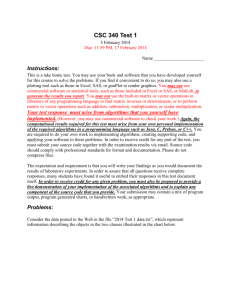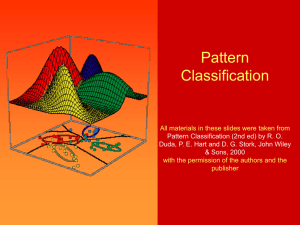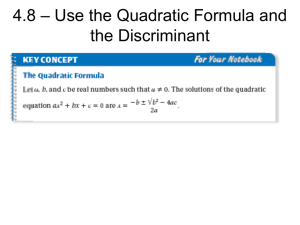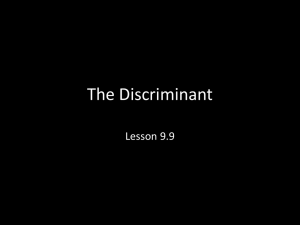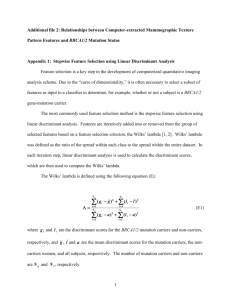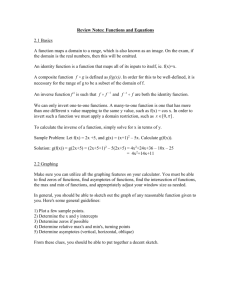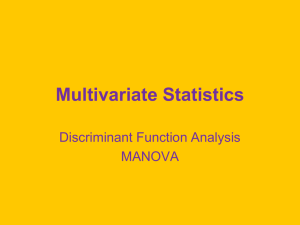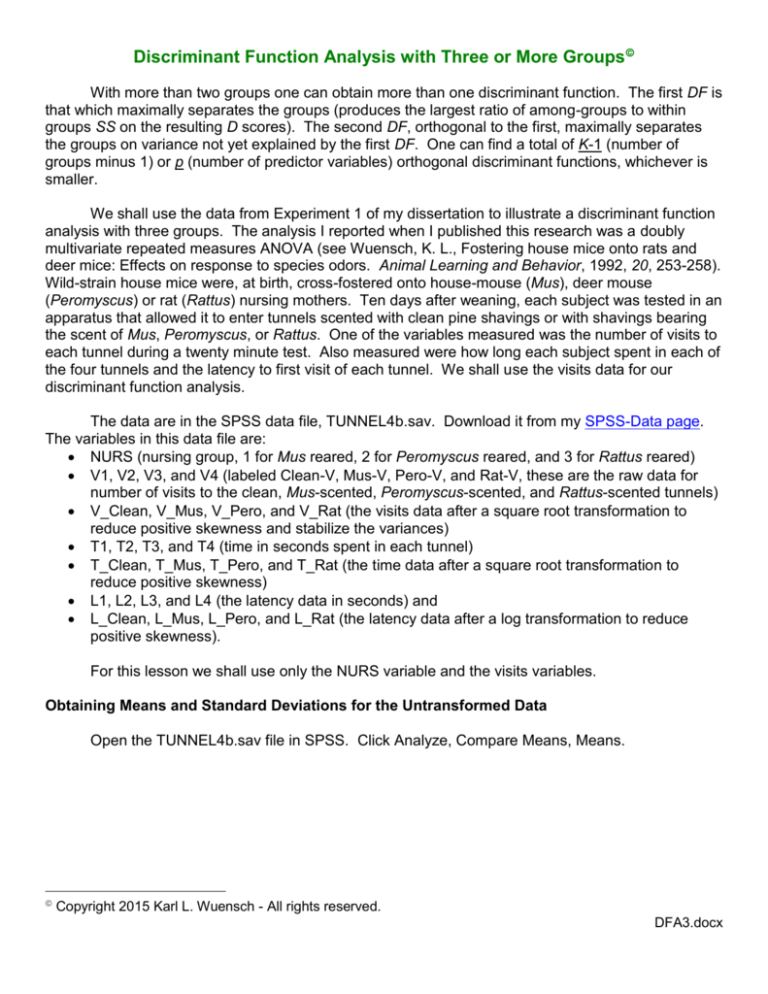
Discriminant Function Analysis with Three or More Groups
With more than two groups one can obtain more than one discriminant function. The first DF is
that which maximally separates the groups (produces the largest ratio of among-groups to within
groups SS on the resulting D scores). The second DF, orthogonal to the first, maximally separates
the groups on variance not yet explained by the first DF. One can find a total of K-1 (number of
groups minus 1) or p (number of predictor variables) orthogonal discriminant functions, whichever is
smaller.
We shall use the data from Experiment 1 of my dissertation to illustrate a discriminant function
analysis with three groups. The analysis I reported when I published this research was a doubly
multivariate repeated measures ANOVA (see Wuensch, K. L., Fostering house mice onto rats and
deer mice: Effects on response to species odors. Animal Learning and Behavior, 1992, 20, 253-258).
Wild-strain house mice were, at birth, cross-fostered onto house-mouse (Mus), deer mouse
(Peromyscus) or rat (Rattus) nursing mothers. Ten days after weaning, each subject was tested in an
apparatus that allowed it to enter tunnels scented with clean pine shavings or with shavings bearing
the scent of Mus, Peromyscus, or Rattus. One of the variables measured was the number of visits to
each tunnel during a twenty minute test. Also measured were how long each subject spent in each of
the four tunnels and the latency to first visit of each tunnel. We shall use the visits data for our
discriminant function analysis.
The data are in the SPSS data file, TUNNEL4b.sav. Download it from my SPSS-Data page.
The variables in this data file are:
NURS (nursing group, 1 for Mus reared, 2 for Peromyscus reared, and 3 for Rattus reared)
V1, V2, V3, and V4 (labeled Clean-V, Mus-V, Pero-V, and Rat-V, these are the raw data for
number of visits to the clean, Mus-scented, Peromyscus-scented, and Rattus-scented tunnels)
V_Clean, V_Mus, V_Pero, and V_Rat (the visits data after a square root transformation to
reduce positive skewness and stabilize the variances)
T1, T2, T3, and T4 (time in seconds spent in each tunnel)
T_Clean, T_Mus, T_Pero, and T_Rat (the time data after a square root transformation to
reduce positive skewness)
L1, L2, L3, and L4 (the latency data in seconds) and
L_Clean, L_Mus, L_Pero, and L_Rat (the latency data after a log transformation to reduce
positive skewness).
For this lesson we shall use only the NURS variable and the visits variables.
Obtaining Means and Standard Deviations for the Untransformed Data
Open the TUNNEL4b.sav file in SPSS. Click Analyze, Compare Means, Means.
Copyright 2015 Karl L. Wuensch - All rights reserved.
DFA3.docx
2
Scoot V1, V2, V3, and V4 into the Dependent List and Nurs into the Independent List. Click
OK
The output produced here is a table of means and standard deviations for untransformed
number of visits to each tunnel for each nursing group. Look at the means for the Mus group and the
Peromyscus group. These two groups were very similar to one another. Both visited the tunnels with
moderate frequency, except for the rat-scented tunnel, which they avoided. Now look at the means
for the Rattus-reared group. These animals appear to have been much more active, visiting the
tunnels more frequently than did animals in the other groups, and they did not avoid the rat-scented
tunnel.
Look at the standard deviations for V4. There is troublesome heterogeneity of variance here.
Conducting the Discriminant Function Analysis
Now let us do the discriminant function analysis on the transformed data. Click Analyze,
Classify, Discriminant. Put V_Clean, V_Mus, V_Pero, and V_Rat into the Independents box. Put
Nurs into the Grouping Variable box.
3
Click Nurs and then Define Range and define the range from 1 to 3.
Continue. Click Statistics and , select Means, ANOVAs, and Box’s M.
Continue. Click Classify and select Casewise Results, Summary Table, Combined Groups
Plot, and Territorial Map.
4
Continue. Click Save and select Discriminant scores.
Continue, OK.
Interpreting the output
Now look at the output. The means show the same pattern observed with the untransformed
data and the standard deviations show that the heterogeneity of variance has been greatly reduced
by the square root transformation.
The univariate ANOVAs show that the groups differ significantly on number of visits to the ratscented tunnel and the clean tunnel, with the differences in number of visits to the other two tunnels
falling short of statistical significance. Box’s M shows no problem with the assumption of equal
variance/covariance matrices.
Look under the heading “Eigenvalues” Two discriminant functions are obtained. The first
accounts for 1.641/(1.641 + .111) = 94% of the total among-groups variability. The second accounts
for the remaining 6%.
5
SPSS uses a Stepwise Backwards Deletion to assess the significance of the discriminant
functions. The first Wilks Lambda testing the null hypothesis that in the population the groups do not
differ from one another on mean D for any of the discriminant functions. This Wilks Lambda is
evaluated with a chi-square approximation, and for our data it is significant. In the second row are the
same statistics for evaluating all discriminant functions except the first. We have only 2 functions, so
this evaluates DF2 by itself. If we had 3 functions, functions 2 and 3 would be simultaneously
evaluated at this point and we would have a third row evaluating function 3 alone. Our second DF
falls short of statistical significance.
To interpret the first discriminant function, let us first look at the standardized discriminant
function coefficients. DF1 is most heavily weighted on V_Rat. Subjects who visited the rat tunnel
often should get a high score on DF1. The loadings (in the structure matrix) show us that subjects
who scored high on DF1 tended to visit all of the tunnels (but especially the rat-scented tunnel)
frequently.
Although it fell short of statistical significance, I shall, for pedagogical purposes, attempt to
interpret the second discriminant function. Both the standardized discriminant function coefficients
and the loadings indicate that scoring high on DF2 results from tending to visit the Peromyscusscented tunnel frequently and the clean tunnel infrequently.
Under “Functions at Group Centroids” we are given the group means on each of the
discriminant functions. DF1 separates the rat-reared animals (who score high on this function) from
the animals in the other two groups. DF2 separates the Mus-reared animals (who score high on this
function) from the Peromyscus-reared animals. If you look back at the transformed group means you
can see this separation: Compared to the Peromyscus-reared animals, the Mus-reared animals
visited the Peromyscus-scented tunnel more frequently and the clean tunnel less frequently.
Territorial maps provide a nice picture of the relationship between predicted group and two
discriminant functions. Look at the map on our example data. Subjects with D1 and D2 scores that
place them in the area marked off by 3’s are classified into Group 3 (rat-reared). The marks the
group centroid. Group 3 is on the right side of the map, having high scores on DF1, (high activity and
no avoidance of the rat-scented tunnel). Subjects with low D1 and high D2 scores fall in the upper left
side of the map, and are classified into Group 1 (Mus-reared), while those with low scores on both
discriminant functions are classified into Group 2 (Peromyscus-reared).
When the primary goal is classification, all discriminant functions (including any that are not
significant) are generally used. Look at the Casewise Statistics from our example analysis. The
classifications are based on probabilities using both discriminant functions. For example, for subject
1, .881 = P(Group = 2 | D1 = -1.953 and D2 = -1.684), while the posterior probability of membership in
Group 1 is .118. Accordingly, this subject is classified as being in Group 2 (Peromyscus-reared),
when, in fact, it was in Group 1 (Mus-reared).
The combined groups plot, “Canonical Discriminant Functions,” is best viewed in color, since
group membership is coded by color. In this plot you can see where each subject falls in the space
defined by the two discriminant functions
6
Canonical Discriminant Functions
nurs
3
Mus
Pero
Rat
Group Centroid
Function 2
2
1
Mus
Rat
0
Pero
-1
-2
-2
-1
0
1
2
3
4
5
Function 1
The Classification Results show that knowledge of the animals’ behavior in the testing
apparatus greatly increased our ability to predict what species of animal reared it. If we were just
guessing, we would expect to have a 33% success rate. Using the discriminant function, we correctly
classify 83% of the rat-reared animals and 62% of the other animals.
Follow-Up Analysis
Look back at the data set. At the very end you will find two new variables, Dis1_1 and Dis2_1.
These are the rats’ scores on the two discriminant functions. I find it useful to make pairwise
comparisons on the means of the discriminant functions and on the means of the predictor variables
which had significant univariate effects.
Click Analyze, Compare Means, One-Way ANOVA. Scoot NURS into the Factor box and
scoot into the Dependent List V_Clean, V_rat, Dis1_1, and Dis2_1.
7
Click Post Hoc and select LSD.
Continue. OK.
Look at the output from the ANOVA. For either discriminant function take the Among Groups
sums of squares and divide by the Within Groups sum of squares. You get the eigenvalue for that
discriminant function. Now take the Among Group sums of squares and divide by the total sum of
squares and then take the square root of the resulting R2. You get the canonical correlation for that
discriminant function. Finally, for the last (second) discriminant function, take the Error sum of
squares and divide by the total sum of squares. You will obtain the Wilks Lambda for that
discriminant function.
8
The multiple comparisons show that on each the rat-reared group differs significantly from the
other two groups on number of visits to the clean tunnel, on number of visits to the rat-scented tunnel
and on the first discriminant function.
Presenting the Results of a Discriminant Function Analysis
The manner in which the results are presented depends in part on what the goals of the
analysis were -- was the focus of the research developing a model with which to classify subjects into
groups, or was the focus on determining how the groups differ on a set of continuous variables. In
the behavioral sciences the focus is more often the latter.
You should pay attention to the example presentations in Tabachnick and Fidell. Here I
present the results of the analysis done during this lesson.
Results
In order to determine how the nursing groups differed with respect to their response to the four
scented tunnels, we conducted a discriminant function analysis. The data were subjected to a square
root transformation prior to analysis, to reduce positive skewness and stabilize the variances.
The first discriminant function was statistically significant, = .341, 2(8, N = 36) = 33.92, p <
.001, but the second was not, = .900, 2(3, N = 36) = 3.32, p = .34. As shown in Table 1, high
scores on the discriminant function were associated with having made many visits to the tunnels,
especially to the Rattus-scented tunnels.
Table 1
Structure of the Discriminant Function
Variable
Visits to Rattus-scented tunnel
Visits to clean tunnel
Visits to Peromyscus-scented tunnel
Visits to Mus-scented tunnel
Loading
.92
.40
.30
.30
Univariate analysis showed that the nursing groups differed significantly on visits to the Rattusscented tunnel, F(2, 33) = 22.98, MSE = 0.72, p < .001, and the clean tunnel, F(2, 33) = 4.54, MSE =
1.10, p = .018, but not on visits to the other two tunnels, .08 < p < .10.
Table 2 contains the classification means for the groups on the discriminant function as well as
the group means on each of the four original variables. Fisher’s procedure was employed to make
pairwise comparisons. It should be noted that when employed to make pairwise comparisons among
three and only three groups, Fisher’s procedure has been found to hold familywise error at or below
the nominal rate and to have more power than commonly employed alternative procedures (Levin,
Serlin, & Seaman, 1994). The Rattus-nursed mice scored significantly higher on the discriminant
function than did mice in the other two groups and made significantly more visits to the Rattusscented and the clean tunnels than did mice in the other two groups. All other pairwise comparisons
fell short of statistical significance.
9
Table 2
Group Means on the Discriminant Functions and the Original Four Variables
Variable
Discriminant Function 1
Discriminant Function 2
Visits to Rattus-scented tunnel
Visits to clean tunnel
Visits to Peromyscus-scented tunnel
Visits to Mus-scented tunnel
Rattus
1.70A
-.09A
12.75A
10.25A
7.92A
10.50A
Nursing Group
Peromyscus
1.16B
-.34A
1.50B
4.58B
4.33A
6.00A
Mus
0.54B
.43A
3.33B
4.67B
5.58A
6.25A
Note. Within each row, means having the same letter in their superscripts are
not significantly different from each other at the .05 level.
Return to Wuensch’s Statistics Lessons Page
Copyright 2015 Karl L. Wuensch - All rights reserved.


